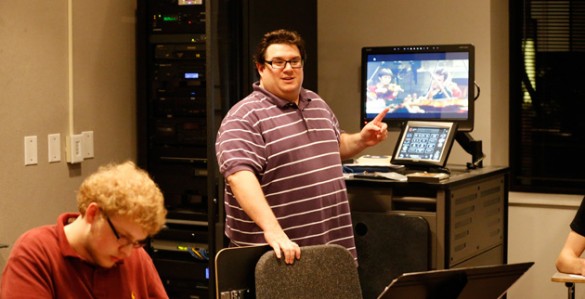
For James Maiello, assistant professor of musicology and ethnomusicology at the Blair School of Music, teaching and research are two sides of the same coin.
Maiello, who came to Blair in 2008, teaches both collegiate and precollege music history courses. His interest in music history grew while completing a degree in music education. He taught middle school while writing his doctoral dissertation in musicology. The combination of teaching a broad range of ages and doing research is a good fit for him.
“There’s no place else I would have the opportunity to do this,” Maiello said. “My research is on Gregorian chant and music and identity in medieval Italy, and then I teach 12-year-olds. It’s a really great mix to be able to exercise both sides of my brain and both sides of my academic life.”
All precollege certificate students must take the precollege music history track. The first year is a chronological survey of music history; the second year tackles special topics such as Bach and his background, the development of opera, and music and nationalism. During the final semester, students also pick a topic of interest to research.
“They plan out the topic and how they want to approach it,” Maiello said. “The first year we did it, the class decided to do Brahms but to bring their instruments and talk about it as they played.
“The second year is a bit more progressive in approach,” Maiello explained. “We deal more with social context and activity in the second half to get them trying [different] things.”
Maiello’s precollege students keep an interactive notebook, with one side for their notes from class and readings and the other side for them to process the information in any way they like, such as making charts or drawing pictures.
“The lecture model doesn’t really work with middle and high school students,” Maiello said, but he finds the challenge fun.
“Adapting different teaching styles and different assessment styles is just as interesting as my research,” he said. “I came out of a family of public school teachers. [rquote]The idea that teaching is something that intellectually you treat like research—methodically, like a profession instead of a job—was something ingrained in us growing up.”[/rquote]
Maiello’s precollege students respond well to his approach. Attending the two-year sequence as a cohort, the students and Maiello get to know each other, and students frequently drop back in to visit once they’ve finished the sequence. They also place well in their college music history classes.
“I think it prepares them well for doing college courses, and not just college courses in music,” Maiello said. “It prepares them well for critical thinking and the kind of academic work they’re going to find.”
“It’s just as intellectually stimulating to figure out how best to reach a 12-year-old’s brain as it is to look at chant melodies and transmission across Western Europe,” Maiello said. “They’re two different sides of my academic life, but they’re both interesting.
“And I think I get more out of it than the students do, actually,” he added.
by Bonnie Arant Ertelt
bonnie.ertelt@vanderbilt.edu